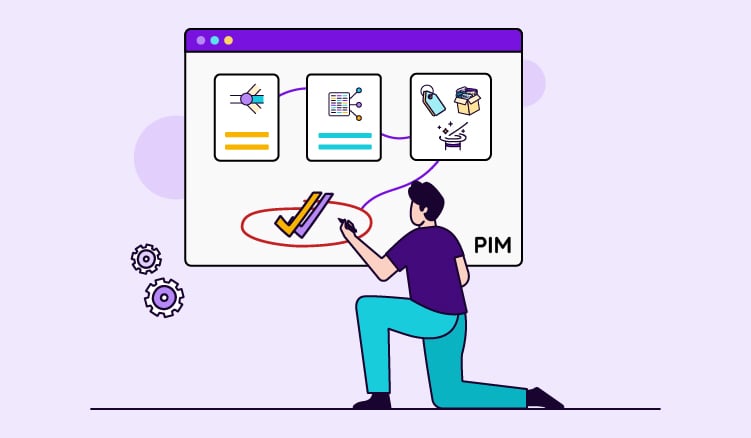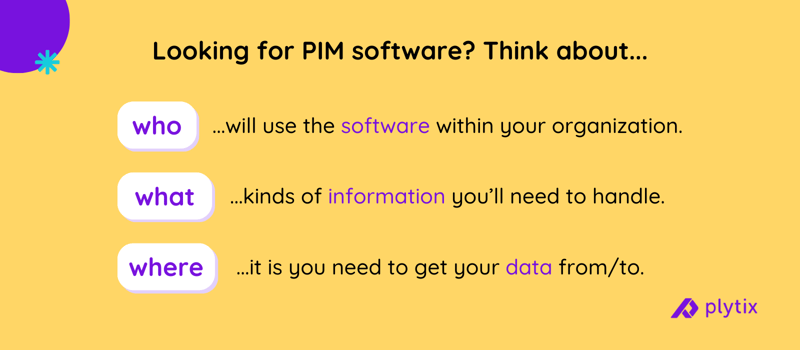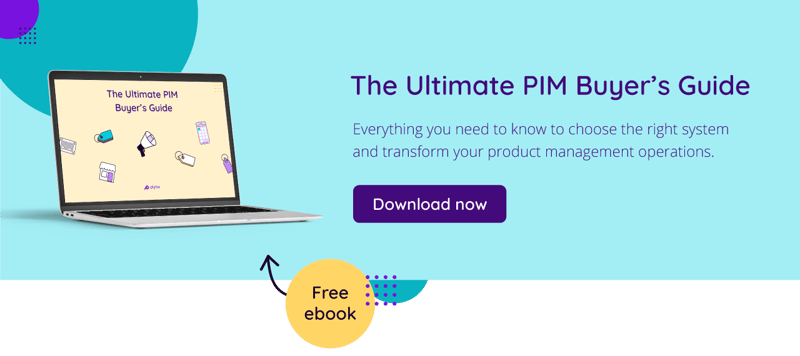
Keep the good stuff coming
Subscribe to our blog newsletter and get monthly content that helps you manage product data smarter.
No spam. Just real value.
Managing your product information can take forever when you’re selling online. In fact, BigCommerce reports that companies spend on average 25 minutes per SKU per year just removing or updating old information. While that may not sound too bad in theory, it rapidly adds up—for a company with 1000 SKUs, that comes to about 417 hours per year, or more than 10 work weeks of an employee only working on that task and nothing else.
No wonder, then, that more and more companies are using technology to help cut down the time they spend dealing with product information. In particular, Product Information Management or PIM solutions are getting more and more popular, which is probably why the global PIM software market is predicted to reach over 26,000 million USD in 2028.
But with so many different PIM options available, how do you go about finding the one that’s right for you? And once you’ve found one, how do you make sure you implement it the right way? Simple—you follow the five steps in this article! Let’s get started.
Step one: Understand what PIM is (and why it matters)
First things first, let’s make sure we’re all on the same page by going over what exactly we mean by “PIM”. PIM, or Product Information Management, refers to the practice of collecting, organizing, enriching, and distributing all of the data associated with your products. That data can include technical specifications, marketing material, logistics information, or even digital assets like images, videos, audio files, and so on.
Having an effective PIM strategy is essential in modern ecommerce for a number of reasons. Firstly, it’s fundamental for providing your customers with accurate, complete, and consistent information across all of your channels. On top of that, it can help to automate a massive amount of your workflow and improve communication, collaboration, and synchronization between different teams and platforms.
Synchronization: Essential for an effective high five.
This is particularly relevant for companies that are embracing a multichannel or omnichannel strategy, so about 94% of retail companies out there at the last count. Strategies like these are all about making the most effective use of multiple channels in order to reach and sell to the maximum customer base possible, while keeping your branding and information consistent . This simply wouldn’t be possible without PIM, and if you want to learn more, our guides to multichannel and omnichannel are right here.
In addition, as new ecommerce trends emerge like AR marketplaces and AI, a strong PIM strategy becomes increasingly crucial for businesses looking to adapt quickly. AR requires detailed product information for virtual experiences, while AI uses it for personalized recommendations. A well-thought-out PIM strategy means businesses are ready to efficiently update and manage this data, helping them stay agile and ahead of the curve in a rapidly evolving digital marketplace—but more on that story later.
If managing all the different elements of this strategy sounds like a lot of work, don’t worry! Specialized PIM software has been designed to help make the whole process a lot simpler. It covers the four main aspects of product information management by:
- Providing a space for you to store all your product information and multimedia in one place
- Having tools to help you quickly sort, search, and filter through it all
- Making it easy for you to get everything into the optimal state for all the different sales channels you sell on, and finally,
- Giving you various download, export, and automatic update options for sending your data and assets out into the world.
What’s more, some PIM solutions can even use AI to generate content for your products, saving you hours of work.
Step two: Find the right PIM software to help
Okay, so now that we’ve established what PIM is, why it’s important, and how software can help, let’s move on to how to find the best particular software for your PIM needs. When you’re deciding which PIM software makes the most sense for you and your organization, three of the most crucial factors to consider are the who, the what, and the where.

There are various questions you can ask to figure out the details of these factors—here are a few suggestions to get you started:
Who
- Is one person or team responsible for your product information, or do various people or teams manage different parts of it?
- Who gives final approval before sending data out to your sales channels?
- If something about your products changes in terms of logistics, marketing, or any other department, how does that change then get reflected in your product information?
- Who in the company is going to be the main person responsible for overseeing the onboarding and implementation of the new PIM tool?
What
- What kinds of information do you need your PIM software to handle?
- What are your multimedia management needs? Will you need a separate DAM system?
- How are your products organized in terms of hierarchies, collections, related products, and so on?
- Is your product information subject to any internal or external validation?
Where
- What other systems (like ERP) will your PIM software need to fetch data from?
- What kinds of connections do those systems support?
- Where do you need to send your product data, in terms of sales and marketing channels?
- What’s the most efficient way to send that data out?
Once you have the answers to these questions, and others that may arise, you can use that information to help choose the right PIM software. Whichever names or departments came up in the who section should be involved in (or at least consulted about) the selection process—after all, they’re going to be the ones using it! Then you can use the technical information from the what and where sections as criteria to help narrow down your selection, and find a PIM tool that you know will be able to meet your needs. If it helps, we’ve got another handy guide you can download on just that topic—what are the odds?
Essentially, the most important thing to do at this point is plan—after all, to fail to plan is to plan to fail. David Alarcón, resident ecommerce expert at Plytix PIM, recommends doing the following.
“Draw up an activity and role map that includes all collaborators involved in the process as well as what aspects of your current processes need to be adjusted to include your new PIM tool. Pre-assign people you believe are the right people to handle the responsibility of successfully managing this new platform.”
Then, when you’ve found the right PIM tool for you, the fun can really begin—starting with getting the right content into your system before sending it out into the world.
Step three: Fill your PIM system with the right content
Okay, let’s move on to the bread and butter of any PIM strategy: quality content. Ever heard the expression “Content is king”? Well, in the world of PIM, it's more like the supreme ruler of the universe—I mean, it’s literally what PIM is all about. Having quality content doesn’t just mean filling your product detail pages with info, it means creating content that resonates with your audience and search engines alike. You need to make sure it covers all the necessary areas as well—after all, up to 70% of consumers will abandon a purchase if the product information is poor quality or incomplete.
First up, SEO optimization. By infusing your product descriptions with the right keywords, you make it easier for your customers (and Google) to find you. It’s like giving your products a megaphone on the crowded street that is the internet, so they can stand out and cut through the noise.

But it's not just about being heard. Your content needs to align with your brand’s voice too. Getting this wrong would be like if you walked into a trendy sneaker store and all the product descriptions sounded like they were written by a 19th-century novelist—kinda weird, right? Well, unless it was a super hipster place and that was their gimmick… but anyway…
Brand-aligned content makes sure your products don’t just speak to your audience but that they speak to them in the right way—the same way you do. It’s not just about completeness and accuracy, it’s about connecting, engaging, and resonating with your customers. This is where market research plays a pivotal role, and even working with an external firm if and when necessary. Yates Jarvis, founder of a leading online ecommerce marketing consultancy agency, had this to say:
"Fill your PIM system with the right content. Another high-performance methodology for optimizing the content loaded into your PIM is market research. Working with an ecommerce market research firm allows you to test your product information against your exact target market to see which styles of presenting the information will perform better than others. This can often be accomplished very quickly among hundreds of prospective customers within just a week."
Doing the right research, integrating the insights you gain, and getting the right content into your PIM system means you can be sure that you’re communicating effectively with your market, which significantly ups your potential for success.
Step four: Manage your content the right way
Now, onto the nitty-gritty of managing this content effectively. Think of it as organizing a fancy dinner party where everyone’s needs are met, using the magic of targeting, accessibility, and governance.
- Targeting is about knowing your guestlist inside out, i.e. who's coming to dinner and what they like to eat and drink. It means tailoring your product information to engage the people you’re trying to reach. If your target audience loves detailed technical specs, give them that. If they prefer quirky stories about your products, then go ahead and quirk it up—Zooey Deschanel would be proud.
- Accessibility is about making sure everyone in attendance can easily reach the dish or drink they’re after once they’re sitting at the table. In PIM terms, this means making your product information easy to find and use, both for your team and your customers. PIM software really comes into its own at this point, as it gives you not only a well-organized database but also a user-friendly interface to access it with—provided you’ve chosen the right software option.
- Lastly, governance. This is all about keeping an eye on what you’re serving. Governance means setting up systems to keep your data in check, and make sure it's accurate, up-to-date, and consistent. Again, there are a bunch of PIM features that can help with this—think of it as a kitchen supervisor, making sure no outdated or incorrect product info ends up in front of your guests.
In a nutshell, weaving these elements into your PIM strategy is like throwing the best dinner party in town—one where your guests end up buying your products, which is the goal of any good dinner party, right? Adapting your information to different marketplaces and audiences, making sure it’s easily accessible, and then staying on top of it in terms of accuracy and completeness helps give your potential buyers a souped-up customer experience (pun absolutely intended). That, in turn, will increase your conversion rate and ultimately boost your sales.

Step five: Integrate PIM with the rest of your business strategy
PIM doesn’t exist in isolation inside your company—it’s connected to a whole bunch of different areas, and as a result, can benefit your business in a whole bunch of different ways (in case that hasn’t been clear so far). With that in mind, there are various aspects of your business strategy that it’s worth thinking about when establishing your PIM strategy.
PIM and your long-term goals
Investigating the various different ways PIM can support your long-term business plans is definitely going to pay off in the end. After all, integrating PIM into your long-term strategy isn't just about managing product information, it's about making the best possible use of that information in order to achieve your broader business goals.
If you think of your business strategy as a script for your company's future, then PIM is the backstage crew. Any crew worth their salt will help make your project possible, sure, but a really great one will go above and beyond to improve the production quality in ways you didn't even think possible—Oscars, here we come.
For instance, if your goal is to expand into new markets, your PIM strategy and software can help you keep your product information adaptable and relevant for different regions. If you want to be the first company in your sector to roll out new products in response to market trends, then PIM can help you cut your time-to-market in half. If your focus is on improving customer experience, PIM plays its part by delivering accurate and detailed product information—which is key to customer satisfaction. Basically, you shouldn’t think of PIM or its software as a standalone strategy or tool, but as an integral part of your journey towards achieving your company’s long-term objectives.

PIM and workflow optimization
Moving onto data management and workflow optimization, let’s start by simplifying the topic (and moving away from some of those inevitable buzzwords 😅). In plain terms, this is about getting your product information organized and making sure everyone in your team can use it effectively. An optimized PIM system turns a pile of unstructured data into a well-organized library, so your team can spend less time hunting down information and more time using it to make informed decisions and strategies.
It all comes down to setting up a system where everything has its place, so that every process can run as smoothly as possible. This is why it’s worth evaluating each of the processes inside your company that make use of product information—to see if they can be improved upon with an updated PIM strategy or thanks to the features of whatever PIM software you’re using. This audit of your processes can lead to better productivity, a smoother operation overall, and, ultimately, your team working smarter, not harder.
PIM and personnel (=professional PIM people, perhaps?)
Speaking of your team, let's talk about the people behind the system. The success of a PIM system hinges on the people who use it every day. Skilled personnel are crucial for not just implementing the PIM system but also for maintaining it over time.
It's about having team members who understand the ins and outs of your products and can translate that into the PIM system effectively. It's also about making sure those team members have the right training and support to use the PIM system to its full potential. Remember, the most sophisticated technology can only go so far without the right people to wield it.

Top tech tip: Turn your device on before attempting to use it.
All in all, integrating PIM into your business plan means seeing it as a key player in your long-term strategy, making sure your data and workflows are neatly organized, and recognizing the invaluable role your team plays in making the most out of your PIM system.
Step six: Enjoy the benefits of an effective PIM strategy (and make sure you keep enjoying them)
Finally, let’s talk about reaping and maintaining the rewards of your PIM strategy after all that work. Having meticulously selected the right software, filled it with top-tier content, and integrated it across your business, you're probably thinking it’s time to just sit back and enjoy the fruits of your labor. But as every ecommerce blogger out there (including me) likes to remind us, "the world of ecommerce is ever-evolving"—so your PIM strategy needs to be dynamic, not static.

The immediate benefits that you'll see are pretty clear: more efficient management of product information, smoother workflows, and a better customer experience—but that’s just the beginning. A robust PIM strategy translates into tangible business growth. You’ll likely see an uptick in sales due to improved product discoverability and customer trust. Plus, with more efficient processes, your team can focus on innovation rather than getting bogged down in data management.
However, establishing your PIM strategy and then just sitting back and forgetting about it is not an option, tempting though it may be. Like I said, the digital landscape is constantly shifting, so your PIM strategy should constantly evolve too. This means regularly reviewing and updating your PIM software, staying on top of the latest trends in ecommerce, and being ready to adapt your strategy to new technologies and market demands. Think AI advancements, shifts in consumer behavior, or even global market changes.

What AI thinks ecommerce looks like—pretty, right?
Another key aspect is continuous training and development for your team. As your PIM system grows more sophisticated, your team's skills need to keep pace. Encourage ongoing learning, provide resources for professional development, and foster an environment where feedback and innovation are valued. Remember, a well-trained team is as crucial as the software itself.
And finally, don’t forget to measure the success of your PIM strategy. Set clear KPIs and metrics to track performance. Are you seeing a reduction in time spent managing product information? Is there an increase in customer satisfaction or sales conversions? By monitoring these metrics, you can fine-tune your strategy for even better results.
Bonus step: Read our in-depth guide
In the end, an effective PIM strategy is like a well-oiled machine—it requires quality input, regular maintenance, and occasional upgrades to keep running at peak performance. So, buckle up and enjoy the ride, because with a full-throttle PIM strategy in place, the sky's the limit for your ecommerce success (much like Danny and Sandy flying off at the end of Grease).
Want to learn more about the different PIM software options out there? The downloadable guide below has everything you need, from a recap of the key aspects of PIM to an in-depth comparison of some of the top players on the market. Oh, and it’s free—enjoy!

Frequently Asked Questions
PIM stands for Product Information Management. It refers to the practice of handling all the data associated with a company's products. This includes gathering, organizing, enriching, and distributing product data such as technical specifications, marketing material, logistics information, and digital assets like images and videos.
A PIM plan is a strategic approach to managing product information effectively. It involves selecting the right PIM software, populating it with high-quality, SEO-optimized content, integrating it seamlessly across different business channels, and maintaining it regularly. A PIM plan aims to streamline workflow, improve communication and collaboration among teams, and ensure consistent and accurate product information across all sales and marketing platforms.
In marketing, PIM is integral for maintaining brand consistency and enhancing customer experience. It's about ensuring that accurate, detailed, and appealing product information is readily available across all marketing channels. This helps in creating effective marketing strategies, as it provides a comprehensive and organized database of product details and digital assets that can be utilized for targeted marketing campaigns, personalization, and improving customer engagement.
A PIM system works by serving as a central repository for all product information. It allows businesses to store, organize, and manage product data in one place. This system usually includes tools for sorting, searching, and filtering data, making it easy to update and maintain. It also facilitates the optimization of content for different sales channels and offers options for exporting and updating product information across various platforms. Advanced PIM systems can even incorporate AI to automate and enhance content generation, further reducing the workload involved in managing product information.

What if your product data actually worked for you?
We’ll show you how Plytix helps you stop fixing data—and start using it.
Related posts
Keep the good stuff coming
Subscribe to our blog newsletter and get monthly content that helps you manage product data smarter.
No spam. Just real value.






Think others should see this?
Go ahead and share it.